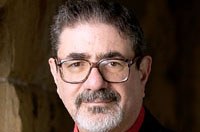 "I'm a chemist and I've found a way to make a cheap device to screen whether or not you are carrying TB", Richard Zare, Professor of Chemistry at Stanford University (USA), told our TWAS reporter excitedly over coffee.
"I'm a chemist and I've found a way to make a cheap device to screen whether or not you are carrying TB", Richard Zare, Professor of Chemistry at Stanford University (USA), told our TWAS reporter excitedly over coffee.
Excitement was, indeed, the hallmark of Zare's later presentation: his eagerness to communicate what was initially for him an intriguing and original piece of research with potential applications in other fields, which quickly evolved into a method for reducing the spread of tuberculosis in developing countries.
Tuberculosis, or TB (short for tubercle bacillus) is a common, and too often lethal, infectious disease caused by various strains of mycobacteria. The disease typically attacks the lungs, but can also affect the kidney and liver. It is spread via airborne saliva by people who have an active TB infection coughing or sneezing.
Overall, an astounding one third of the world's population is currently infected with the tuberculosis bacillus. "It's the second most infectious disease in the world," confirms Zare: "HIV/AIDS is the first."
"TB is treatable", he explains, "but it needs extensive - and expensive - chemotherapy. New infections are occurring at the rate of 1 per second. In 2010 there will be 8.8 million new cases and 1.45 million needless deaths." If left untreated the bacillus kills more than 50% of those infected. Moreover, the distribution of tuberculosis is not uniform across the globe; about 80% of the population in many Asian and African countries test positive in tuberculin tests, compared to only 5–10% of the United States population.
Clearly, diagnosing the disease in its early stages would contribute to a reduction in the associated death rate, and would also have an impact on the spread of the disease, since carriers would be made aware that they were contagious. Hitherto, diagnosis of active TB relies on radiology (commonly chest X-rays), as well as microscopic examination and the microbiological culture of body fluids. The culture-based methods are limited by the slow proliferation rate of the microbes and the requirement of specific conditions to grow the culture.
"M. tuberculosis divides every 15-20 hours, which is very slow compared to E. coli, for example, which divides every 20 minutes. So the diagnosis can take up to 6 weeks. So imagine, a person comes to get tested then walks around for 6 weeks without knowing it, infecting people." There is a test called the Acid Fast Stain, which is quicker, but there is a 50% chance of getting a false negative (and those chances increase in developing countries because, for example, in many cases laboratories are poorly equipped). Other culture-free methods require expensive instrumentation and disposables.
"We think our method overcomes most of these problems", says Zare. "I'm really excited about this collaboration with my postdoctoral research associate, Kagning Ren, and a faculty member from the Stanford School of Medicine, Niaz Banaei. So far, we've just done experiments in the lab - but we need to take the research into the field."
The method involves creating a kind of chemical fingerprint of the bacillus using a mould. "You put the TB bacteria on a glass plate, then you take the plate and press it into a goo-based polymer which forms around the cells. It surrounds the bacteria, rearranging itself to use the minimum energy (as polymers do). Then you harden the glue and it becomes solid, then remove the bacteria by washing and shaking. What you have then is a mould that is the shape and size of the cells. You then take potentially infected sputum and you wash it over this surface. What happens is that the surface preferentially captures the bacteria out of the phleghm. It's amazing, the mould gets special bacillus-detecting properties!"
This method of attracting the infectious bacteria could save a great deal of time and money. For example, it is quick to carry out, and does not need any refrigeration or other special laboratory facilities – beyond a simple microscope to view the results. What’s more, by tweaking various components of the polymer mould, the tests can be made almost 99% accurate.
Back to coffee, Zare explained what it meant to him to have been selected as a TWAS Associate Fellow (15% of TWAS members are elected from developed countries, but they must have distinguished themselves by their efforts to promote science in developing countries) many years ago. His response was typically eager and unequivocal:
"I'm very interested in promoting science throughout the world. I believe that the number of smart people is in proportion to the number of people in the population. The world gains by using the talents of those smart people. Think about the "zero sum game". Chequers, bridge, they're zero sum games: for every winner there's a loser. Science is not a zero sum game, it's win-win."
And what about being asked to give a TWAS Medal Lecture? "Well, of course it's always nice to be recognized and appreciated. But what drives me is not going for medals and prizes. I'm driven by the need to share my discoveries. So, in fact, this prize has given me the opportunity to present my work in front of all these eminent scientists from developing countries. It's not often you get an audience like that. That's the real value."
You can see a photograph of Richard Zare receiving his plaque from President Hu in this report on the conference in the Global Times.

